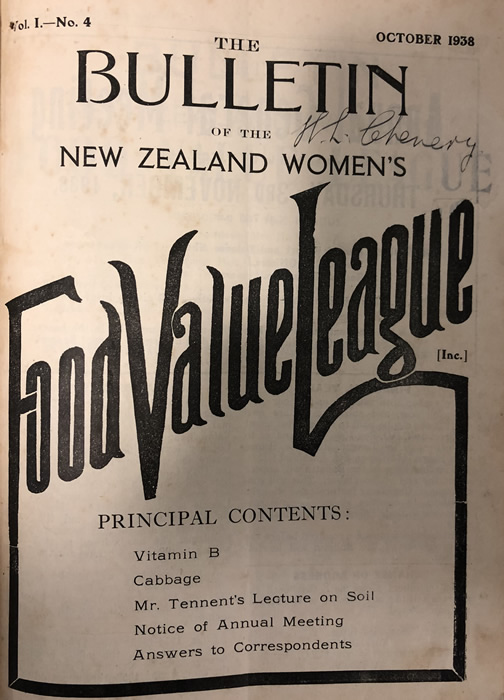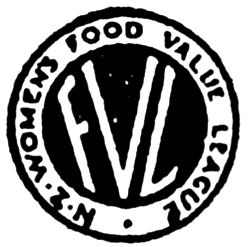This essay written by Sandra Coney was first published in Women Together: a History of Women's Organisations in New Zealand in 1993.
The New Zealand Women's Food Value League was formed towards the end of the Depression of the 1930s—a time when low household incomes aggravated existing health and dental problems suffered by New Zealanders. The league's principal objects were to improve food standards and to educate the public in 'the grammar of nutrition'. [1] The inspiration for the league came from Dr Guy Chapman, an Auckland dentist with outspoken views on diet and health, who saw women as having a special role in educating other women.
The league was formed as a women's group because it was women who bought and cooked the food for households. To avoid any accusations that commercial interests were involved, it was to be 'a union of housewives only'. [2] A driving force in the formation of the group, which incorporated in Auckland in December 1937, was Betty Lorimer, an MSc graduate and analytical chemist who worked at the Kelvin Laboratories in Auckland. Other key members were Dorothea Turner and May Martin-Smith (a former teachers' training college biology teacher), editors of The Bulletin of the N.Z. Women's Food Value League, Dr Violet Hastings, Wyn Good (who succeeded Lorimer as secretary), Dr Barbara Roche, and Agnes Loudon (headmistress of Epsom Girls' Grammar School). The membership was urban and middle class, and committee members tended to be highly educated. Many were professional women, for example doctors, teachers, and university staff.

Cover of The Bulletin of the N.Z. Women's Food Value League, October 1938.
Membership grew rapidly: by the end of the first year it had reached 2500, and the first branch had been formed in Palmerston North. Other branches followed in Wellington, Hutt Valley, Christchurch, Hamilton, and Dunedin, although the headquarters and the executive remained in Auckland. [3] In Dunedin, key members were Professor Elizabeth Gregory of the School of Home Science, and her predecessor, Professor Ann Gilchrist Strong, as well as nutritionist Dr Muriel Bell.
Committee members studied nutritional information in overseas publications and passed it on to members through The Bulletin. Knowledge about vitamins was relatively new in the 1930s, and the New Zealand diet typically contained a great deal of over-cooked, low-fibre food, and bottled fruit with a high sugar content. While there was 'no actual hunger in our midst', said the league, children were fed 'lower grade "filling" foods' rather than 'high grade protective foods'. [4] The league stressed the value of fresh fruit and vegetables all year round, and argued for the benefits of parsley, wholegrain cereals, raw cabbage, and seaweed. It promoted home gardening and composting, and lobbied for state houses to have fruit trees planted in their gardens. Specially imported wheat mills were installed in the league's Auckland office, and also sold to members. Improving the quality of food in state institutions and, during the war, in army camps, was another league concern.
But if housewives were eager for nutritional information, commercial interests and government departments were less co-operative. A long campaign to get bakers to use league wrappers guaranteeing the wholemeal content in bread made little headway (although the league did manage to get a standard weight for bread by regulation). An equally long battle to improve milk quality in urban Auckland was more successful, leading to a Milk Commission in 1943, at which the league was legally represented. The Commission's report resulted in the Milk Act 1945, which established Milk Authorities to control milk quality in all urban areas.
In addition to The Bulletin, the league spread nutritional information through a regular page in the feminist magazine Woman To-Day, wall charts, public meetings, and radio broadcasts—in Auckland, it ran weekly sessions with Marina in her women's programme on 1ZB. When World War II brought rationing and food shortages, accurate information about food content became increasingly important: 'Never was the need greater for an intelligent policy on nutrition, and the Food Value League feels that now its work is both more urgent and more difficult.' [5]
After the war, with continuing food shortages, shortened shop hours and reduced home deliveries, the league faced a new problem which 'dwarf[ed] any that we tackled in the first few years'—the difficult position of the housewife, who now found that the wartime state of emergency had 'become a permanent one'. [6] Yet membership was falling, from 2200 in 1940 to 1285 in 1948. It was in fact the increased burden on women in the home which led to a decision to disband the league in August 1948: 'women of the necessary ability are no longer free to take on work outside their homes. . . .' [7].
League funds came entirely from subscriptions and sales of The Bulletin, and this was never adequate to establish the laboratory to analyse the nutritional value of food that had been dreamed of in the early years. In addition, the Department of Health, which had initially responded to league enquiries by telling it to mind its own business, was by the late 1940s carrying out public instruction in nutrition; Plunket nurses and adult education groups had also picked up the work. Having pioneered nutritional work in New Zealand, the league felt able to disband 'with little sense of failure', [8] but rather with the satisfaction of a job well done.
Sandra Coney
Notes
[1] Interview with Dorothea Turner, October 1991.
[2] Bulletin, Vol. 1 No. 1, December 1937, p. 1.
[3] The league had a small office in Queen Street, with a full-time typist.
[4] Bulletin, Vol. 11 No. 2, March 1939, p. 3.
[5] Bulletin. Vol. 11 No. 4, October 1939, p. 3.
[6] Bulletin, Vol. XI No. 4, August 1948, pp. 3-4.
[7] Bulletin, Vol. XI No. 4, August 1948, p. 3.
[8] Bulletin, Vol. XI No. 4, August 1948, p. 4.
Unpublished sources
Coney, Sandra, interview with Dorothea Turner,Wellington, 1991
Published sources
Bulletin of the N.Z. Women's Food Value League, 1937–1948, ATL
Milk Commission, 'Report on the Supply of Milk to the Four Metropolitan Areas of Auckland, Wellington, Christchurch and Dunedin', AJHR Vol. II, H-29A, 1944, pp. 1–132
Smee, Mary (Dobbic), 'The Investigators Investigated', Woman To-Day, August 1938, p. 16
Women's Food Value League, Calling All Cooks, Unity Press,Auckland, 1947


Community contributions